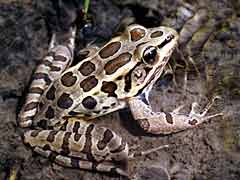
Source of Image
Notes for Chapter 27: Early Tetrapods and Modern Amphibians
Click link to return to Lecture
Schedule
or back to Chapter 26
or ahead to Chapter 28
Chapter 27 Assignment:
538-548, 556-557; RQ-27: 1-3, 8-9, 12
Next: Ch. 28: 559-571, 576-579; RQ-28: 2-5, 7, 10, 16-17
Then: Ch. 30: 609-621, 624-626, 634-639;
RQ-30: 1-2, 6-8, 11, 15-16 (last two lectures)
Introduction: From Water to Land in Ontogeny and Phylogeny
Featured Animal: Pickeral frog (Rana palustris)
More Links: 1
- 2
- 3
- 4
- 5 - 6
I. Movement onto Land
II. Early Evolution of Terrestrial Vertebrates
III. Modern Amphibians
A. Caecilians: Gymnophiona
B. Salamanders: Caudata
i. Breeding behavior
ii. Respiration
iii. Paedomorphosis
C. Frogs and Toads: Anura
i. through p. 548
ii. Fig. 27-26: life cycle of frog
The following outline of lecture notes does not follow Ch. 27 headings.
Also note, the text cladogram figures have some problems. Here are more details.
Bony fishes - ray-fin and lobe-fin clades
ray-fins include teleosts (most vertebrates, 96% of fishes)
lobe-fins include coelacanths, lungfish, rhipidistians, and tetrapods
Important fossil tetrapods
- Ichthyostega, Acanthostega
What are tetrapod features and how do they reflect life on land?
Describe 3 types of respiration in a salamander.
What is paedomorphosis? Example: the axolotl
Click link to return to Lecture
Schedule
or back to Chapter 26
or ahead to Chapter 28
This page created 11/6/01 © D.J. Eernisse, Last Modified 11/06/01, Links Last Completely Checked 11/06/01